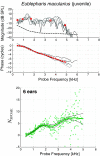Comparison of otoacoustic emissions within gecko subfamilies: morphological implications for auditory function in lizards
- PMID: 21136278
- PMCID: PMC3046335
- DOI: 10.1007/s10162-010-0253-0
Comparison of otoacoustic emissions within gecko subfamilies: morphological implications for auditory function in lizards
Abstract
Otoacoustic emissions (OAEs) are sounds emitted by the ear and provide a non-invasive probe into mechanisms underlying peripheral auditory transduction. This study focuses upon a comparison of emission properties in two phylogenetically similar pairs of gecko: Gekko gecko and Hemidactylus turcicus and Eublepharis macularius and Coleonyx variegatus. Each pair consists of two closely related species within the same subfamily, with quantitatively known morphological properties at the level of the auditory sensory organ (basilar papilla) in the inner ear. Essentially, the comparison boils down to an issue of size: how does overall body size, as well as the inner-ear dimensions (e.g., papilla length and number of hair cells), affect peripheral auditory function as inferred from OAEs? Estimates of frequency selectivity derived from stimulus-frequency emissions (emissions evoked by a single low-level tone) indicate that tuning is broader in the species with fewer hair cells/shorter papilla. Furthermore, emissions extend outwards to higher frequencies (for similar body temperatures) in the species with the smaller body size/narrower interaural spacing. This observation suggests the smaller species have relatively improved high-frequency sensitivity, possibly related to vocalizations and/or aiding azimuthal sound localization. For one species (Eublepharis), emissions were also examined in both juveniles and adults. Qualitatively similar emission properties in both suggests that inner-ear function is adult like soon after hatching and that external body size (e.g., middle-ear dimensions and interaural spacing) has a relatively small impact upon emission properties within a species.
Figures




References
-
- Aranyosi A, Freeman D. Two modes of motion of the alligator lizard cochlea: measurements and model predictions. J Acoust Soc Am. 2005;118:1585–1592. - PubMed
-
- Bergevin C, Velenovsky D, Bonine K. Abstracts of the thirty-third midwinter research meeting. Anaheim: Association for Research in Otolaryngology; 2010. Otoacoustic emission temperature dependence across the lacertilia.
Publication types
MeSH terms
Grants and funding
LinkOut - more resources
Full Text Sources

